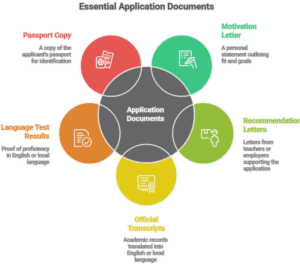Ready to turn your European university dream into reality? Understanding the admission requirements for European universities is your first ticket to enrolling in top programs across the continent. Here’s the thing, Europe offers thousands of bachelor’s and master’s degrees taught in English and local languages, but the entry rules can feel like a maze.
Don’t worry, by the time you finish this guide, you’ll know exactly which qualifications, tests, and documents to prepare, plus all the deadlines you need to hit. You’ll also discover tips on funding and program types so you can pick the best fit for your goals. Let’s jump in.
Understand applicant categories
Before you dive into forms and transcripts, it helps to know where you stand. Admission rules differ for EU citizens, international students, and those with special visas.
EU citizens benefits
If you hold citizenship from an EU country, you usually apply under the same conditions as local students. That means:
- No additional visa hurdles
- Often the same tuition fees as nationals
- Access to country-specific grants and scholarships
You won’t need to prove visa eligibility, but you may still take language tests if your program isn’t in your home language. To learn more about admission timelines, see our guide on european university admission 2026.
International student routes
As a non-EU applicant, you follow international entry criteria. Common steps include:
- Checking if your high school diploma matches local qualifications
- Proving language skills in English or the host language
- Applying for a student visa
Visa requirements can vary by country. Always check official embassy sites early to avoid last-minute surprises.
Check academic qualifications
Academic benchmarks are the backbone of your application. You’ll need to match your school transcripts or standardized test scores with European standards.
Required school diplomas
Most bachelor’s programs ask for a secondary school leaving certificate comparable to the local A-levels or International Baccalaureate. For example:
- Germany looks for the Abitur equivalent (GPA, SAT scores, relevant courses) Beyond the States
- Some Dutch universities accept U.S. high school diplomas plus SAT or ACT
If you have AP credits or an IB diploma, map them carefully to program requirements. Europe generally cares more about meeting core criteria than stacking extracurriculars.
Standardized test options
Not every school asks for the SAT or ACT, but many top programs use them to compare diverse backgrounds.
SAT acceptance in Europe
A growing number of universities in the UK, Netherlands, and other countries accept the SAT instead of local entrance exams. Typical score expectations:
| Program type | Minimum SAT score |
|---|---|
| General bachelor’s | 1200 |
| Business and management | 1350 |
| Top-tier universities | 1450+ |
To skip extra tests, aim for a score above your target school’s range. Five Lands Education recommends taking the SAT twice in the year before enrollment to hit your best score Five Lands Education.
University entrance exams
In some countries you’ll face national or university-specific tests. For instance:
- France: Baccalauréat or prep school concours
- Switzerland: University entrance exam per canton
- UK (Oxbridge): Admissions tests like the TSA or LNAT
Plan ahead, because these exams often occur months before application deadlines.
Prove language skills
Language proficiency is crucial. Even if your program is in English, you may need to show local language ability for daily life or certain courses.
English proficiency tests
Commonly accepted exams include:
- TOEFL iBT (internet-based Test of English as a Foreign Language)
- IELTS Academic (International English Language Testing System)
- Cambridge English qualifications
Most universities ask for a minimum of CEFR level B2. Test scores usually expire after two years, so schedule your exam well before applications open European Education Area.
Local language requirements
If you plan to study in German, French, Spanish, or another local language, you may need:
- A B2 or C1 certificate under CEFR
- Passing a university language test
- Submitting proof of previous study in that language
Check each program’s page for specifics. Some schools allow you to attend language courses before your degree starts.
Test validity and timing
- Book tests 3–6 months before applications close
- Allow time for score reporting (up to 4 weeks)
- Retake if you miss the minimum requirement
Planning language exams early avoids last-minute stress.
Explore program alternatives
Europe’s higher education landscape isn’t one-size-fits-all. You’ll choose between universities of applied sciences and research universities.
Universities of applied sciences
These institutions focus on practical training and industry links. Features include:
- Internships or work placements
- Smaller class sizes
- Bachelor’s programs lasting 3–4 years
- Limited research requirements
If you want a hands-on degree in fields like engineering or business management, this is your route.
Research universities distinction
Research universities offer theory-driven curricula and often require:
- A thesis or capstone project
- Strong academic records
- Master’s degrees that last 1–2 years full time
They’re ideal if you plan to pursue a PhD or a career in research. Make sure your bachelor’s coursework aligns with their prerequisites.
Plan tuition and funding
Sorting out finances early keeps your options open. Fees and funding vary widely between countries and programs.
Tuition fee overview
| Student type | Bachelor’s fees per year | Master’s fees per year |
|---|---|---|
| EU citizens | €0–€3,000 | €0–€4,000 |
| Non-EU students | €1,000–€20,000 | €2,000–€30,000 |
Generally, Europe is more affordable than U.S. public universities, where international fees can reach $70,000 per year European Commission.
Grants and scholarships
- Erasmus+ grants for EU and partner countries
- Country-specific scholarships (e.g., DAAD in Germany)
- University merit-based awards
- External foundations or employer sponsorship
Apply early, since some scholarships close before program applications.
Navigate application process
Once you know what’s required, it’s time to apply. A clear timeline keeps you on track.
Application deadlines and intakes
Most European universities have one main intake in September or October. Some also offer a winter entry in January. Deadlines often fall 6–9 months before term start.
January intake options
If you need a later start or extra prep time, explore january intake universities in europe 2026.
Masters deadlines
Many master’s programs set firm deadlines in December or January. For full details on dates, check our European universities masters application deadlines 2026.
Core application documents
You’ll typically upload these items:

Some schools require certified translations. Verify each university’s format rules.
Motivation letters
Showcase your passion, relevant achievements, and reasons for choosing that country or city. Keep it focused and authentic.
Recommendation letters
Select referees who know your academic or professional work. Provide them with a brief on the program’s focus.
Transcripts and certificates
Order official documents early. If your grades come from multiple institutions, combine them in one dossier.
Interviews and admissions tests
Top programs may add an extra layer of screening.
Subject-specific exams
Oxford and Cambridge use tests like the Thinking Skills Assessment (TSA). They assess critical thinking and subject knowledge Sophie Pomme.
Holistic interviews
Universities of all types may invite you for an interview via video call. Prepare examples of your academic work and future plans.
Compare grading scales
Understanding how your GPA maps to European systems helps you set realistic targets.
Country grading scales
| Country | Scale type | Range |
|---|---|---|
| Germany | Numeric | 1 (best)–5 |
| Netherlands | Numeric | 1–10 |
| UK | Letter grades | A–F |
| Spain | Percentage | 0–100 |
GPA equivalence
Most admissions teams convert your GPA to their scale. A 3.5 on the 4.0 U.S. system usually translates to:
- Germany: 1.9–2.3
- Netherlands: 7.5–8.0
- UK: Upper second class (2:1)
If you’re unsure, ask the admissions office for guidance.
Recap next steps
- Review whether you apply as an EU or international candidate
- Confirm your academic and test requirements
- Book language exams and standardized tests early
- Choose between applied sciences or research universities
- Calculate tuition fees and hunt scholarships
- Note deadlines for fall and winter intakes
- Prepare your motivation letter, references, and transcripts
- Practice for interviews or subject tests
Now it’s your turn. Pick one admission requirement to tackle today, whether that’s booking your TOEFL spot or drafting your motivation letter. Once you’re set, share your progress or questions in the comments below so we can all help each other succeed. Visit the EU Info Hub for more information.
















1 thought on “Don’t Miss Out: Admission Requirements for European Universities Explained”